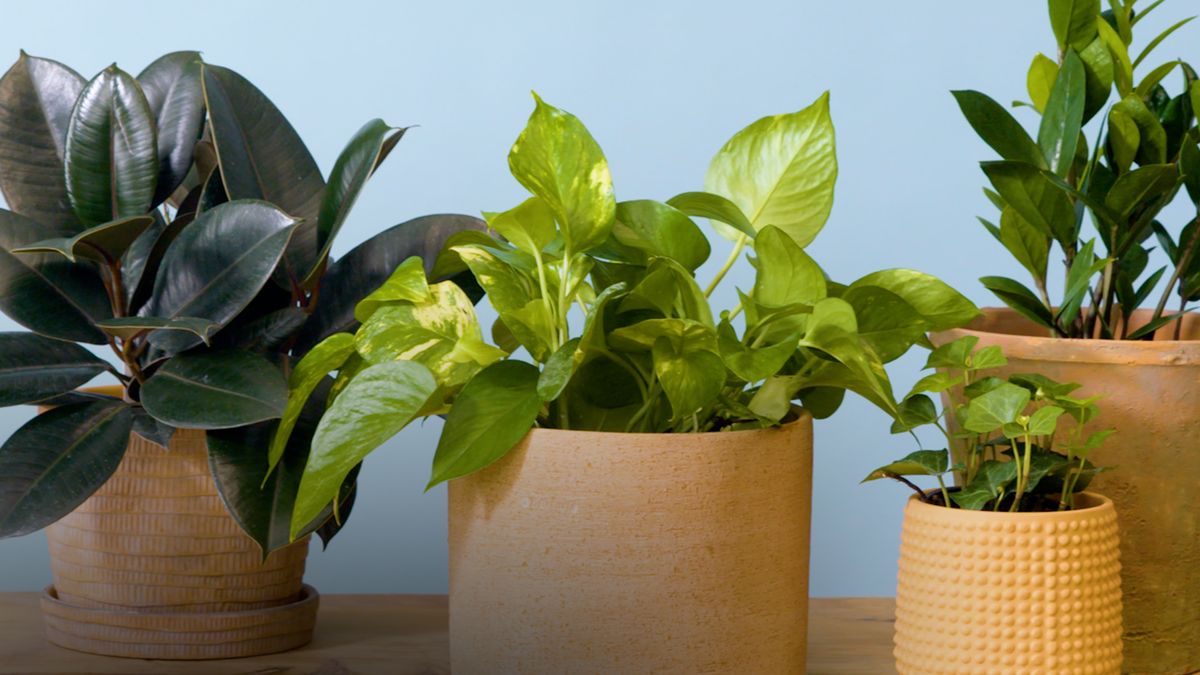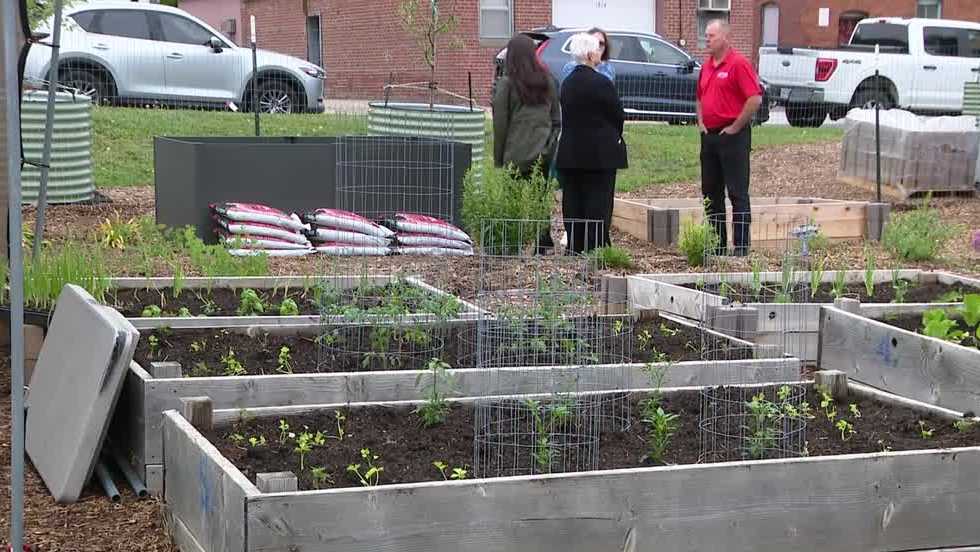Aloe Vera Plant Benefits

As mentioned, the gel from aloe vera plants has been used to treat sunburns and moisturize dry skin for many, many years. It also works for acne, cuts, scrapes and stings, according to WebMD. Plus, aloe vera juice can help detox the body, according to Aly Stoffo, owner of Glam Gardener NYC.
Beyond its medicinal properties, the popular houseplant can bring a touch of the outdoors into any home without consuming too much of your time. So if you’re someone who loves plants but doesn’t have too much time to take care of them, aloe vera might be the right pick for you.
How to Grow Aloe Vera Plants

Aloe has won over many home gardeners with its hardiness and tolerance of infrequent watering. Below, find tips on soil, sunlight, water and more.
- Soil: Stoffo recommends “well-draining soil so that when they are watered, the soil doesn’t retain too much water and rot the roots.” Your best bet is to mix equal parts sand and potting soil or buy a special succulent mix. The terracotta also dries faster than other plastic or glazed containers.
- Sunlight: Place your aloe in a bright, sunny place. Otherwise, it will go dormant and stop growing. “Aloes grow in very hot environments. The more heat and sun the better,” says Stoffo. If you like, you can move the potted plant outdoors for the summer, but don’t put it in direct sunlight right away. Gradually place it in a brighter spot every few days to prevent overexposure.
- Water: “They don’t mind a little neglect and dry spell between waterings, but when you do water them, water them very well,” says Satch. Water the plant heavily about once every two weeks, waiting until the soil dries out fully. Since this is a desert species, keeping the dirt moist will cause the roots to rot. Limp or brown leaves also signal you’ve overdone the water.
- Climate: If you live in a warm climate year-round (Zone 10 or higher on the USDA Plant Hardiness Map), you can nurture your aloe outside. Freezing temperatures will kill the leaves, but you really have to worry about frozen soil, as that will kill the roots and no new sprouts will grow.
- Fertilization: While fertilization isn’t needed, you can fertilize plants once a year in the spring. When picking fertilizer, choose one that contains phosphorus — a nutrient that can help plants grow.
Advertisement – Continue Reading Below
Varieties of Aloe Vera

There are more than 500 species of aloe, separated into three categories: tree aloes, shrub aloes and stemless aloes. Luckily, in terms of care, what works for one succulent will work for the others. To help you pick the right aloe plant for your home or garden, consider these details:
- Aloe vera: This popular stemless plant has thick, greenish leaves that fan out from the central stem. While the leaves can grow 30 to 40 centimeters long, the flower stalk can reach 90 centimeters high.
- Aloe aristata: Known for the white teeth attached to the edge of their leaves, these stemless succulents are poisonous and lack health benefits. They can grow 8 to 12 inches tall, making them ideal plants for containers.
- Aloe polyphylla: Once you see this plant, you’ll know exactly why it’s called the spiral aloe. Their short leaves are arranged in rows that spiral in the same direction. During the spring and summer months, they produce red to salmon-pink blooms.
How to Help an Aloe Vera Plant Flower

Naturally, aloe vera plants will flower better in direct sunlight outdoors. If you live in a warmer environment, try placing the aloe plant outdoors in the summer. However, remember to slowly introduce the plant to more light little by little to prevent overexposure.
If you notice your aloe vera is wilting or that the leaves are turning yellow or brown, you may be overwatering the plant, which would make it more difficult for it to flower. You can also try using fertilizer in the spring. However, make sure to apply it conservatively.
Advertisement – Continue Reading Below
How to Harvest an Aloe Vera Plant

Besides their visual appeal, aloe leaves contain a clear gel that’s a popular home remedy. According to the Mayo Clinic, this substance may shorten the healing of first- and second-degree burns and promote wound healing. Applying aloe gel to the skin could also help reduce acne and redness caused by mild to moderate psoriasis.
With this in mind, you can snip off an aloe leaf (as close to the stem as possible) when you need it and rub the juicy end on a sunburn or sore spot.
Some people also like to use aloe vera juice as a hair conditioner, makeup remover or even brow gel. While there’s no guarantee it’ll work as well as some of your favorite products, you can get more of the juice by slitting the spike lengthwise and scooping out the contents with a spoon. As long as the plant stays healthy, it’ll just keep making more!
How to Propagate an Aloe Vera Plant

This may surprise you, but you can indeed grow an aloe vera plant from cuttings. However, it’s not a reliable plant propagation method, so there’s a low chance of the plants being viable. Before removing the aloe pups (otherwise known as the baby plants part of the root system), make sure it’s at least one-fifth the size of the aloe plant. When it’s time, remove the dirt from the pup’s base. Use a clean, sharp knife to cut the aloe pup from the aloe plant. Plant your pup in a new pot filled with potting mix and allow it to sit for one week before you start watering. In terms of care, you can treat your pup as you would your aloe.
Stoffo offers one piece of advice to those who are willing to put in the hard work needed for successful propagating: “You have to be patient. Cut the leaf, let the cut end dry, then place it in well-draining soil and WAIT!”
Advertisement – Continue Reading Below
How to Repot an Aloe Vera Plant

A succulent with small roots, aloe doesn’t need to be replanted often — only when you notice that the roots are crowded or that the plant is tipping over in the pot.
“You can use any soil. They are not picky. Desert soils are sandy and poor, so they can handle a lot. Just ensure that they are getting enough direct sun and heat to dry properly between waterings,” says Satch.
Keeping that in mind, upsizing the plant can prevent stunted leaf growth and wilting leaves. According to Home for the Harvest, it’s recommended to repot aloe plants in the spring while they’re actively growing. Follow our steps below (and watch our step-by-step video above for visuals):
- Choose a pot that’s heavy enough to support your succulent and drains well.
- Water the plant 24 hours before starting. If the aloe looks overwatered (withering leaves), you can skip this step.
- Gently remove the aloe plant from its pot. If the roots get caught, slowly cut them.
- Place the plant in its new pot with a good-quality potting mix.
- Don’t add too much soil, as the roots need breathing space. Water immediately after repotting.
Katarina Avendaño (she/her) is the senior SEO editor for Good Housekeeping, where she writes and edits lifestyle content and contributes to SEO strategy. Before joining GH in 2021, she was the digital editor at New York Family, where she was responsible for the website’s content and strategy. Katarina received her bachelor’s degree in communications and Spanish from the University of Washington.
Laura Millar (she/her) is the assistant lifestyle editor for Good Housekeeping, where she covers home design. Prior to joining Good Housekeeping in 2024, she wrote for NBC’s TODAY.com, where she covered everything from entertainment news to pop culture updates.
Watch Next

Advertisement – Continue Reading Below
Advertisement – Continue Reading Below
Advertisement – Continue Reading Below



